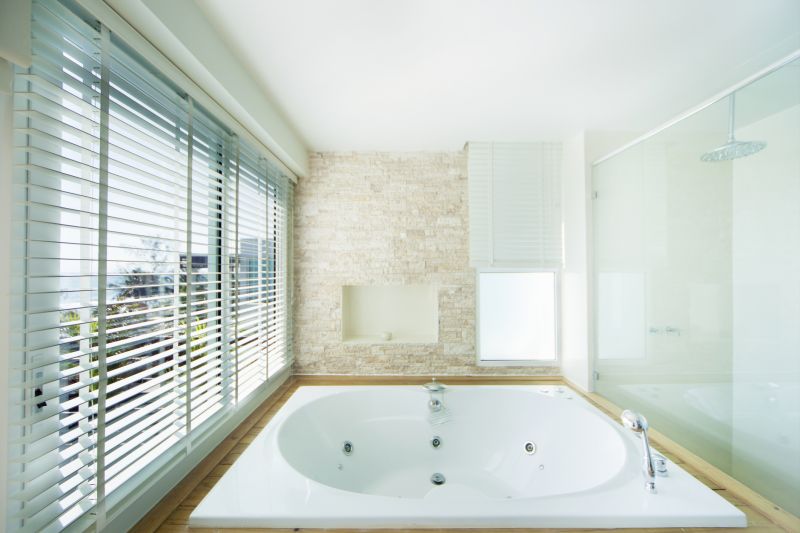Leading Products For Bathtub Refinishings To Refresh Your Space
Choose from the best tools and materials that simplify the refinishing process and deliver stunning results.
 Bathtub refinishing products offer a practical solution for revitalizing worn or outdated bathtubs without the need for full replacement. These products typically include specialized coatings, primers, and sealers designed to adhere to various surface materials such as porcelain, acrylic, or fiberglass. When selecting refinishing products, it is important to consider compatibility with your existing bathtub surface, ease of application, and the desired finish appearance. Proper preparation and application are essential to achieve a durable and aesthetically pleasing result, often transforming the look of a bathroom at a fraction of the cost of renovation.
Bathtub refinishing products offer a practical solution for revitalizing worn or outdated bathtubs without the need for full replacement. These products typically include specialized coatings, primers, and sealers designed to adhere to various surface materials such as porcelain, acrylic, or fiberglass. When selecting refinishing products, it is important to consider compatibility with your existing bathtub surface, ease of application, and the desired finish appearance. Proper preparation and application are essential to achieve a durable and aesthetically pleasing result, often transforming the look of a bathroom at a fraction of the cost of renovation.
Top Overall Option
Epoxy Coating System
An epoxy coating system is widely regarded as a versatile and durable choice for bathtub refinishing. It provides a hard, chemical-resistant surface that adheres well to various substrates. When applied correctly, epoxy coatings can offer a smooth, glossy finish that enhances the appearance of a bathtub. These systems often include primers, epoxy paints, and sealers, making them comprehensive solutions for refinishing projects. While they may require some experience to apply properly, epoxy coatings are valued for their potential to provide a resilient and long-lasting surface that withstands daily use.
Types of Products For Bathtub Refinishings
Epoxy Coatings
Durable, chemical-resistant coatings suitable for various surfaces, offering a glossy finish.
Acrylic Enamels
Ease of application with a smooth finish, often used for DIY refinishing projects.
Polyurethane Topcoats
Provides additional protection with a high-gloss or matte finish, enhancing durability.
Primer Kits
Prepares surfaces for better adhesion and longer-lasting results.
Bonding Agents
Improve adhesion between existing surfaces and new coatings, reducing peeling.
Sealants and Topcoats
Add a protective layer to resist stains, scratches, and water damage.
Spray-On Refinishing Products
Allow for quick application with a smooth, even coat, ideal for small repairs.
Brush-On Refinishing Kits
Suitable for detailed work and touch-ups, providing control over application.
Roller-Apply Coatings
Offer a balance between ease of application and smooth finish for larger areas.
Two-Part Coating Systems
Require mixing before application, often used for professional-grade refinishing.
Water-Based Epoxy Coatings
Simplify cleanup and reduce fumes, suitable for DIY projects.
Solvent-Based Enamels
Provide a durable finish with excellent adhesion, often used in commercial settings.
Textured Coatings
Create slip-resistant surfaces, ideal for safety-focused applications.
Anti-Microbial Coatings
Help inhibit mold and bacterial growth on refinished surfaces.
High-Heat Resistant Products
Designed to withstand higher temperatures, suitable for hot water baths.
Flexible Coatings
Accommodate slight surface movements without cracking, ideal for older tubs.
UV-Resistant Coatings
Prevent discoloration and degradation from sunlight exposure.
Popular Choices
Popular for their durability and professional finish, suitable for DIY projects.
Favored for ease of use and quick drying, often used in home refinishing.
Chosen for fast application and smooth results, ideal for small repairs.
Preferred for detailed work and touch-ups, offering control over application.
Selected for their strong adhesion and resilience in high-use areas.
Popular for providing a glossy, protective finish that enhances durability.
Ease of cleanup and lower fumes make these a common choice for DIYers.
Chosen for safety and slip resistance, especially in households with children or elderly.
Frequently used to add an extra layer of protection after refinishing.
Popular for improving adhesion on challenging surfaces.
Increasingly favored for maintaining hygienic surfaces.
Selected for bathrooms with significant sunlight exposure.
Chosen for older tubs that experience slight movement or cracking.
Ideal for hot water baths, ensuring longevity under temperature stress.
Popular for their fast curing times, reducing project duration.
Refinishing kits and products are available in a range of formulations, from epoxy-based coatings to acrylic enamels. Many products are designed for DIY use, featuring user-friendly instructions and quick-drying formulas. Professional-grade products may require specialized equipment and skills but can offer longer-lasting finishes. It is also worth considering products that provide options for different finishes, such as glossy, matte, or textured surfaces, to match your bathroom decor.
In addition to coatings, there are primers and bonding agents that enhance adhesion and improve the longevity of the refinished surface. Sealers and topcoats can add extra protection against scratches, stains, and water damage. Proper ventilation during application and curing time are crucial to ensure safety and optimal results. Regular maintenance after refinishing can help prolong the life of the new surface, making careful product selection and application techniques vital for successful bathtub refinishing projects.
Key Buying Considerations
- Compatibility with your existing bathtub surface material.
- Ease of application, especially if DIY project.
- Desired finish appearance, such as glossy or matte.
- Durability and resistance to stains, scratches, and water damage.
- Drying and curing times to fit your schedule.
- Ventilation requirements during and after application.
- Level of surface preparation needed before application.
- Availability of primers and bonding agents for better adhesion.
- Protection against mold, mildew, or bacterial growth if relevant.
- Compatibility with hot water or high-temperature environments.
- Type of coating: epoxy, acrylic, polyurethane, etc.
- Safety precautions and VOC content for indoor use.
- Cost considerations and value for money.
- Level of professional skill required for optimal results.
- Shelf life and storage conditions of the product.
